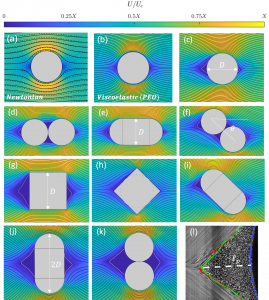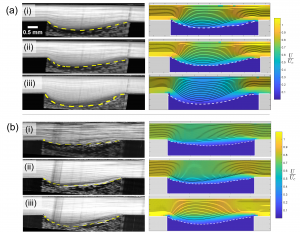Slow viscous flow around an obstacle is a classical problem in fluid mechanics, with its analysis paving the way for the resolution of the so-called Stokes paradox and the development of matched asymptotic expansions. When placed into the confines of a narrow slot – a Hele-Shaw cell – the flow problem becomes (at leading order) equivalent to two-dimensional potential flow around an obstacle. In either case, the problem has fore-aft symmetry owing to the reversibility of the steady flow field. Here, we are concerned with the generalization of these flow problems to the situation in which a complex fluid flows around an obstacle. In particular, following recent work on soft matter and complex fluids, we address the problem of viscoplastic flow around obstacles in a Hele-Shaw cell. The practical applications are widespread, particularly for drilling and fracture problems in the oil and gas industries where unwanted blockages are a key consideration. We study the creation of the blockages in the non–uniform slots by breaking it down to an idealized problem of flow around obstacles in a Hele–Shaw cell.
1. Theoretical Study :
A theoretical study is presented of the flow of viscoplastic fluid through a Hele-Shaw cell that contains various kinds of obstructions. Circular and elliptical blockages of the cell are considered together with stepwise contractions or expansions in slot width, all within the simplifying approximation of a narrow gap. Specific attention is paid to the flow patterns that develop around the obstacles, particularly any stagnant plugged regions, and the asymptotic limits of relatively small or large yield stress. Periodic arrays of circular contractions or expansions are studied to explore the interference between obstructions. 
Finally, viscoplastic flow through a cell with randomly roughened walls is examined, and it is shown that constructive interference of local contractions and expansions leads to a pronounced channelization of the flow. An optimization algorithm based on minimization of the pressure drop is derived to construct the path of the channels in the limit of relatively large yield stress or, equivalently, relatively slow flow.
D. R. Hewitt, M. Daneshi, N. J. Balmforth, and D. M. Martinez. Obstructed and channelized viscoplastic flow in a Hele-Shaw cell. J. Fluid Mech., 790:173–204, 2016.
2. Experimental study (with a focus on determining the origin of fore-aft asymmetry)
Experiments are conducted exploring the flow of Carbopol past obstacles in a narrow slot and
compared with predictions of a model based on the Herschel-Bulkley constitutive law and the conventional Hele-Shaw approximation. Although Carbopol is often assumed to be a relatively simple yield-stress fluid, the flow pattern around an obstacle markedly lacks the fore-aft symmetry expected theoretically. Such asymmetry has been observed previously for  viscoplastic flows past obstacles in unconfined geometries, but the narrowness of the Hele–Shaw cell ensures that the stress state is very different, placing further constraints on the underlying origin. The asymmetry is robust, as demonstrated by varying the shape and number of the obstacles, the surfaces of the cell walls, and the steadiness of the flow rate. The results suggest that rheological hysteresis near the yield point may be the cause of the asymmetry.
viscoplastic flows past obstacles in unconfined geometries, but the narrowness of the Hele–Shaw cell ensures that the stress state is very different, placing further constraints on the underlying origin. The asymmetry is robust, as demonstrated by varying the shape and number of the obstacles, the surfaces of the cell walls, and the steadiness of the flow rate. The results suggest that rheological hysteresis near the yield point may be the cause of the asymmetry.
M. Daneshi, J. MacKenzie, N.J. Balmforth, D. M. Martinez, D. R. Hewitt (2020). Obstructed viscoplastic flow in a Hele-Shaw cell. Physical Review Fluids, 5(1), 013301.
3. Formulating asymmetry
An experimental and computational investigation of the internal flow of elastoviscoplastic fluids over non- smooth topologies is presented in two complimentary studies. In the first study, we visualize the creeping flow of a Carbopol gel over a cavity embedded in a thin slot using Optical Coherence Tomography (OCT) and confocal microscopy. We measure the size and shape of the plug as a function of Bingham and Weissenberg numbers. An asymmetry in the plug shape is observed which is also evident in our second study numerical simulations using adaptive finite element method based upon an augmented Lagrangian scheme. We quantify the asymmetry and present the results as a function of the product of the Weissenberg and Bingham numbers which collapse onto a single curve for each of these geometries. These findings underscore the theoretical underpinnings of the synergy between elasticity and plasticity of these complex fluids.


M.E. Villalba, M. Daneshi, E. Chaparian, D. M. Martinez (2023). Atypical plug formation in internal elastoviscoplastic fluid flows over a non-smooth topology. arXiv preprint arXiv:2301.09100.